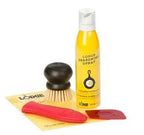Lodge USA Enamel 4.5-Qt Dutch Oven — Frequently Asked Questions
What is the Lodge USA Enamel 4.5-Qt Dutch Oven?
The Lodge USA Enamel 4.5-Qt Dutch Oven is part of Lodge’s **USA Enamel** series — the first line of enameled cast iron cookware made entirely in the United States.
It combines classic cast iron strength with a smooth enamel surface, making it ideal for both cooking and serving.
What are its specifications and standout features?
• **Capacity**: 4.5 quarts / ~4.2 liters
• **Construction**: Enameled cast iron — interior and exterior enamel coating over cast iron core
• **Handles & Hardware**: Stainless steel inlaid handles and stainless steel knob
• **Lid**: A domed, self-basting lid to help recirculate moisture and improve cooking retention
• **Heat Compatibility**: Safe on stovetops (including induction), ovens, and even use in refrigerator/marinating mode
• **Temperature Limit**: Oven safe up to ~500 °F
• **Design / Aesthetics**: Available in several color options (Cherry On Top red, Cloud White, Smooth Sailing blue, Moonstruck gray)
• **Made In**: Manufactured in Tennessee, USA — part of Lodge’s move to U.S.-made enameled cast iron
How should I use this Dutch oven to get the best results?
• Preheat gradually — give the enamel a chance to warm up evenly.
• Use it for stews, braises, soups, roasts, casseroles, baking, and one-pot meals.
• The self-basting lid helps lock in moisture and flavor, especially in longer cooking cycles.
• Use both side handles (with mitts) when lifting, particularly when the pot is full.
• The pot can go from stovetop to oven to table seamlessly, offering versatility in presentation and use.
• Because the enamel is nonreactive, this Dutch oven is well-suited for acidic dishes (tomato, wine sauces, etc.).
How do I care for and maintain this enameled cast iron piece?
• Hand wash only — avoid abrasive cleaners or scouring pads that may damage the enamel finish.
• Use warm, soapy water with soft sponges; avoid strong detergents or metal scrubbers.
• Dry thoroughly and promptly to prevent moisture from lingering under the lid.
• Avoid rapid temperature shifts (thermal shock) — e.g., don’t transfer a hot pot directly into cold water.
• Though the enamel is robust, avoid banging or dropping the piece to prevent chipping, especially along the rim or edges.
• Minor interior staining can sometimes be cleaned with baking soda + water or a nonmetal scrubber designed for enamel.
What are the advantages and limitations?
Advantages:
• No seasoning needed — the enamel surface is ready to use.
• Nonreactive — safe for cooking acidic foods without metallic taste.
• Strong heat retention and even cooking thanks to the cast iron core.
• Attractive finish suitable for serving directly at the table.
• Versatile across heat sources (stovetop, oven, induction) and can handle refrigerated use.
• A milestone product: the first enameled cast iron cookware made fully in the U.S.
Limitations / cautions:
• Heavier than non-cast alternatives — lifting when full requires care.
• Enamel can chip if mishandled or struck, especially at the edges.
• Not ideal for extreme searing where bare cast iron might outperform.
• Requires careful use to avoid thermal shock.
• Enamel thickness slightly reduces the usable internal volume and adds weight.







